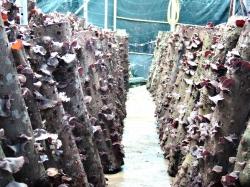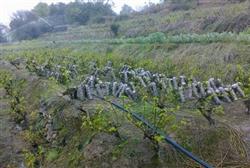High-yield techniques of bag cultivation of Auricularia auricula

In recent years, substitute cultivation of Auricularia auricula has become one of the ways for northern farmers to shake off poverty and become rich. Farmers in Yushu County, using miscellaneous sawdust, corncob and other agricultural by-product resources, planted 800000 bags of black fungus in bags and mined them about 60 days after inoculation. each bag could collect 30 grams of dried fungus, 28000 kilograms of black fungus in that year and 1.2 million yuan in income. A farmer cultivated 8000 bags of Auricularia auricula and collected more than 300kg of dried fungus that year, with a net income of 12000 yuan. Now the high-yield techniques of bag cultivation (Cai Picture 23) are introduced as follows: Auricularia auricula cultivated in Caitu 23 bags can produce auricularia auricula in ㈠ cultivation season. Although the ear comes out quickly in the high temperature season, it is easy to be infected with miscellaneous bacteria after hanging the bag, so it should be staggered in the high temperature season. In general, the original and cultivated seeds should be produced from late December of last year to early January of the following year, and bacterial bags should be produced from the middle of February to the first ten days of March. After 50 days, the outdoor temperature can reach more than 10 ℃ at night and 20: 25 ℃ during the day. The peak season is from May to June, and the last tidal ear can be harvested from September to October. ㈡ culture material preparation can choose the following two formulations: ① sawdust 70%, corncob 10%, rice bran 10%, soybean 6%, sugar 1%, gypsum 3%. ② corncob 50%, sawdust 20%, corn flour 10%, rice bran 10%, soybean powder 8%, sugar and gypsum 1% each. Corncobs should be exposed to the sun before use and then crushed into particles the size of soybeans to improve permeability. When preparing, mix the dry, mildew-free raw material and cooked gypsum powder evenly, adjust pH4.5~5.5, the water content is about 60%, squeeze the material by hand, and there is water seeping out from the gap between fingers without dripping. ㈢ bag sterilization with 17 × 33 cm polypropylene plastic bag, each bag 500g, a section of compaction, after loading, tighten up and lower slightly loose, a vertical inoculation hole in the middle of the bag, bag mouth sleeve 4 cm diameter collar (collar 6 cm away from the material surface), add cotton plug, and then press the bag into an oval stack in the atmospheric pressure sterilizer, keep a certain space in the pot, boil the water with strong fire, when the temperature reaches 100 ℃ Keep it for 10 to 12 hours and cook overnight. In order to prevent the pot from boiling dry, you should pay attention to replenishing water in time when sterilizing. ㈣ inoculation material bags should be quickly moved into the inoculation room when the pot is started, and inoculated when the temperature is below 28 ℃. Generally, each bottle of cultivated species can be inoculated with 25 Mel 30 bags. After inoculation, the bacterial bag should be moved to a dark room to maintain bacteria. The room temperature was controlled at about 26 ℃ in the first 10 days and kept at 20 ℃ after that. Air should be ventilated 3 times a day for 8 minutes each time. The floor of the culture room should be sprinkled frequently, and the indoor air humidity should be kept above 55 / 65%. ㈤ ear shed is built because of the management mode of indoor bacteria infection and outdoor hanging bag, so ear shed should be built outside. The ear shed area depends on the number of hanging bags, the shed is about 2 meters high, and wooden poles are set up on the shed for hanging bags through ropes. The ear shed should be close to the water source, the ground had better lay sand and stone to store water and moisturize, cover the roof and all around the grass curtain, the light should be "three yang and seven yin", the shed should be well ventilated, and the surrounding curtain should be sprayed with dichlorvos or lime powder to disinfect and kill insects. After 50 days of inoculation with ㈥ hanging bag, the hyphae grew to the bottom of the bag and the bag could be hung. Before hanging the bag, it is best to soak it in 5% lime water for 1 minute. After drying, remove the cotton plug and neck ring, tie the bag mouth with a rope, and cut the ear mouth around the bag wall. Use a blade to cut 10 V-shaped or x-shaped openings on the bacterial bag, all of which are 1.52cm long. The notch should not be too large, lest the ear buds grow too dense, the ear pieces differentiate slowly, and the size is irregular. After the cut, the bag is tied to a rope or hung on the wood pole of the ear shed with S-shaped wire. The distance between the bags is 10-15 cm, each rope is 8-10 bags, the whole string is hung, and the hanging density of the space in the shed is 80 bags / square meter. There should be a management channel 1 meter wide between the hanging bags. ㈦ ear management ① should keep the temperature in the shed at about 15 ℃, increase the light during the day, increase the temperature, widen the temperature difference between day and night, stimulate the formation of primordium, and reduce the temperature through space spray, sprinkling water on the ground and hanging wet grass curtains in the high temperature period. In the initial stage of ② hanging bag, the air relative humidity should be controlled at 60% to 80%, and during the peak period, the air humidity should be increased to more than 90%, and water can be sprayed into the space in the morning, noon and evening. ? The ear shed should be ventilated by convection, at night at high temperature and at noon at low temperature. If the ventilation is poor, the concentration of carbon dioxide is too high, and excessive humidity will cause rotten ears, runny ears and infected molds, or malformed ears. ④ should check frequently and immediately remove the contaminated pieces of the bacterial bag with a knife. If the contaminated surface of the bacterial bag is large, the whole bag should be taken out immediately for treatment. ㈧ harvesting and processing can be harvested when the lugs are fully expanded and the length is 5m / 6cm. When picking, handle it gently, cut off the root with a blade, and pick it every 3 days. After ear picking, water spraying should be stopped or reduced, ventilation should be increased, and the rotten ear base should be removed. If it is found that the cut is contaminated by mold, it can be cleaned with a blade to promote the formation of the fruiting body primordium again, and then normal water spray management after the ear buds grow, and the last tide ear should be collected no matter the size or size. The harvested ear pieces should be dried in time. In case of continuous rainy days, wet and dry ears can be mixed for short-term storage. When the weather is fine, dry ears can be taken out and packed in plastic bags to prevent moisture regain. ㈨ Note 1. Select the mother species, breed the original species and cultivated species. The strain cultivated by Duan wood may not be suitable for bag cultivation, and the strain should be white, robust, free of large caking and free of miscellaneous bacteria. two。 The culture material should be fresh, mildew-free and insect-free, and sterilized thoroughly. When leaving the pot, if the cotton plug is damp, be sure to replace it. 3. Bacteria should be strictly aseptic and act quickly to prevent contamination in the course of operation. 4. Strengthen ear management, strict control of temperature and humidity, regular ventilation, appropriate increase of light.
- Prev

High-yield cultivation techniques of Auricularia auricula
The sandy ground or flat grassland with warm climate, small temperature difference between day and night, moist air, sufficient sunshine, close to the water source and not affected by water damage, and the ear field with large cultivation should also take into account the traffic conditions. The land with low-lying terrain and poor drainage should not be used as an ear field. 1.2 after the establishment of the ear field, it is necessary to do a good job.
- Next

Interplanting black fungus in orchard
The benefit of planting Auricularia auricula by trenching between orchard rows is considerable. The main cultivation methods are as follows: 1. The original culture material formula is sawdust 78%, rice bran (or bran) 5%, corncob 15%, gypsum powder 1%, sucrose 1%. Weigh all kinds of ingredients according to the above proportion, first dissolve sucrose in water, then stir sawdust, rice bran and gypsum powder.
Related
- Fuxing push coffee new agricultural production and marketing class: lack of small-scale processing plants
- Jujube rice field leisure farm deep ploughing Yilan for five years to create a space for organic food and play
- Nongyu Farm-A trial of organic papaya for brave women with advanced technology
- Four points for attention in the prevention and control of diseases and insect pests of edible fungi
- How to add nutrient solution to Edible Fungi
- Is there any good way to control edible fungus mites?
- Open Inoculation Technology of Edible Fungi
- Is there any clever way to use fertilizer for edible fungus in winter?
- What agents are used to kill the pathogens of edible fungi in the mushroom shed?
- Rapid drying of Edible Fungi

